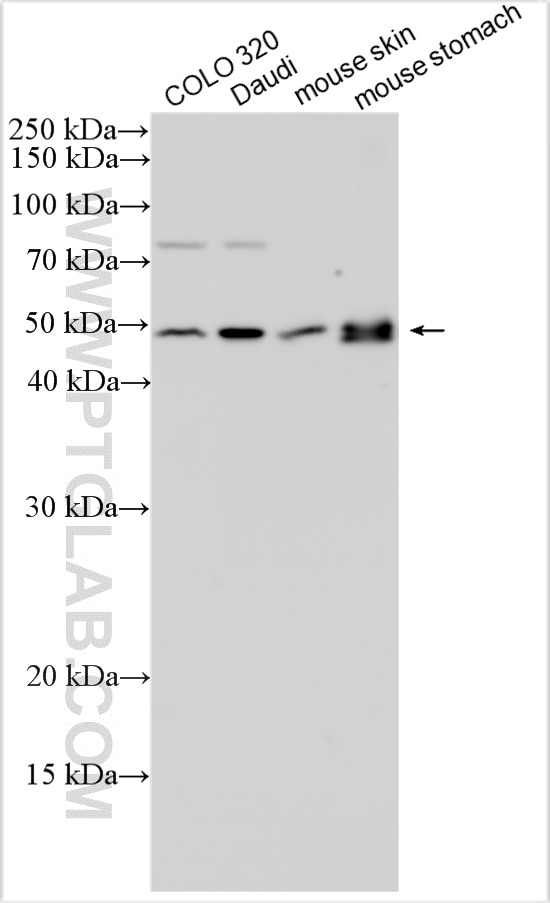Tested Applications
| Positive WB detected in | COLO 320 cells, Daudi cells, mouse stomach tissue, mouse skin tissue |
Recommended dilution
| Application | Dilution |
|---|---|
| Western Blot (WB) | WB : 1:2000-1:14000 |
| It is recommended that this reagent should be titrated in each testing system to obtain optimal results. | |
| Sample-dependent, Check data in validation data gallery. | |
Product Information
30354-1-AP targets GSDMA in WB, ELISA applications and shows reactivity with Human, mouse samples.
| Tested Reactivity | Human, mouse |
| Host / Isotype | Rabbit / IgG |
| Class | Polyclonal |
| Type | Antibody |
| Immunogen | GSDMA fusion protein Ag31284 Predict reactive species |
| Full Name | gasdermin A |
| Calculated Molecular Weight | 445 aa, 49 kDa |
| Observed Molecular Weight | 49 kDa |
| GenBank Accession Number | BC109197 |
| Gene Symbol | GSDMA |
| Gene ID (NCBI) | 284110 |
| RRID | AB_3086299 |
| Conjugate | Unconjugated |
| Form | Liquid |
| Purification Method | Antigen affinity purification |
| UNIPROT ID | Q96QA5 |
| Storage Buffer | PBS with 0.02% sodium azide and 50% glycerol , pH 7.3 |
| Storage Conditions | Store at -20°C. Stable for one year after shipment. Aliquoting is unnecessary for -20oC storage. 20ul sizes contain 0.1% BSA. |
Background Information
Gasdermins, a family of five pore-forming proteins (GSDMA-GSDME) in humans expressed predominantly in the skin, mucosa and immune sentinel cells, are key executioners of inflammatory cell death (pyroptosis), which recruits immune cells to infection sites and promotes protective immunity. GSDMA was predicted to enable phosphatidylinositol-4,5-bisphosphate binding activity, phosphatidylinositol-4-phosphate binding activity, and phosphatidylserine binding activity. Involved in apoptotic process.
Protocols
| Product Specific Protocols | |
|---|---|
| WB protocol for GSDMA antibody 30354-1-AP | Download protocol |
| Standard Protocols | |
|---|---|
| Click here to view our Standard Protocols |



